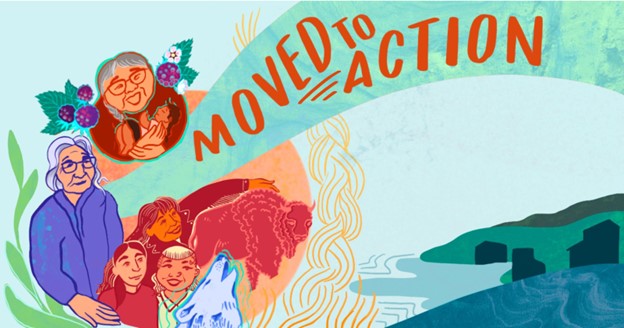from Bradley Clements

This year’s Canadian Museums Association (CMA) National Conference was on the theme of Moved to Action, addressing the CMA’s report of the same name that was released last year. Moved to Action is the CMA’s reply to the Truth and Reconciliation Commission of Canada’s Call to Action number 67, which asked the CMA to report on “museum policies and best practices to determine the level of compliance with the United Nations Declaration on the Rights of Indigenous Peoples and to make recommendations” (TRC 2015). I had the privilege of attending the two-day virtual conference which concluded yesterday afternoon. Recordings of the conference presentations are available to CMA members who registered for the next year, but I wanted to share a brief summary for GRASACers who were unable to join.
The conference began with a beautiful prayer by Elder Dumont (Algonquin Anishinaabe), reflecting on how logs brought together can create a welcoming and calming fire, but if they are spread out the fire will be extinguished. He explained that this is why we must come together with good intentions. CMA Board President Heather George (Euro-Canadian and Kanien’kehá:ka) and Executive Director Janis Monture (Kanien’kehá:ka) – it was her first day on the job! – opened by centering the importance of Indigenous sovereignty and self-determination. Jisgang Nika Collison (Haida), Executive Director of the Haida Gwaii Museum at Kay Llnagaay, delivered a keynote titled Gam gyen iitl’l ising gan, gam t’alang ising ga gan: Nothing about us without us, explaining the history of extractive collecting from Haida Gwaii, followed by Haida repatriation of their Ancestors and creation of their own amazing museum. She concluded by saying “Do not let the TRC and UNDRIP be in vain. Practice yahguudangang [to pay respect]. Be moved to action.” Many examples of people doing just that followed. Jonathan Lainey (Wendat) presented on inspiring activities at the McCord Museum where he is Curator of Indigenous Cultures, stressing that Indigenous voices should be heard throughout heritage institutions, not just in exhibitions. The first day concluded with a profound and wide-ranging discussion by John Hampton (Chickasaw), Executive Director of the MacKenzie Art Gallery, stressing how museums have dehumanized peoples, but how they also have the capacity to foster humanizing respect.
The second day began with “spilling tea” among conference participants and CMA board members, discussing the strengths and aspirations of the heritage field on a range of topics. We were then honoured with the presence of Professor Emeritus Leroy LittleBear (Blackfoot), one of the seminal Indigenous Studies scholars, who “played with our minds” by explaining the metaphysical differences between Blackfoot and European understandings of reality and history, and how this relates to museum work. Following breakout sessions and a break, members of the CMA Reconciliation Council which had guided the creation of the Moved to Action report spoke candidly about the experiences of doing so. This conversation demonstrated how much deeply challenging work goes into such contributions, and concluded on the moving recognition that – in doing this work – we stand on the shoulders of ancestors so that our descendants will be inspired to carry it on. The conference wrapped up with a frank discussion on museum decolonization, passionately and humorously led by curator Dr. Meranda Roberts (Paiute and Chicana) and artist Adrian Stimson (Blackfoot). Heather George summarized the conversation by saying that museums probably cannot decolonize as institutions, but they can support Indigenous sovereignty, self-determination, and land back.
The exciting news that capped off these conversations is that they will continue – notably at next year’s conference! Heather George and Janis Monture announced that this will be in person at Niagara Falls in 2024, on April 9-11, on the pertinent theme of The Future is Collaboration. Keep an eye out for the call for proposals, which will be launched later this spring! GRASACers will be well positioned – in terms of geography and experience – to be part of these conversations on the future of Indigenous-museum relations.
Thank you so much to all who presented and organized this excellent conference. All of the presentations did indeed leave those of us in the audience feeling moved to action.
